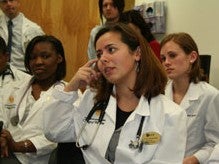The two patients were actually trained actors and both were suffering from severe pain. The simulation was designed to see how students transferred skills they had learned in an academic setting to an urgent patient-care situation. Specifically, the exercise integrated curriculum topics such as anatomy and physiology with the clinical skills of physical diagnosis. Teams of students had to conduct a focused medical history and physical examination while responding empathetically to the patients’ pain and emotional distress.
“This simulation is very unique,” said Dr. Maria Cannarozzi, who worked with other COM faculty members to develop the real-world exercise. “Not many schools are doing this for students who are just in their first or second year.”
Cannarozzi said the students had to manage the stress of a medical crisis, the emotions of patients and family members and their own fears and uncertainties. “We wanted to push them beyond their limits in a safe environment where they could practice their skills,” she said.
There was plenty of emotion to go around in the simulated Emergency Room. One elderly patient was crying out in pain as his daughter pleaded hysterically with the doctors to get him pain medication immediately. Another patient responded to her pain by being hostile and belligerent. “Too many people are asking me questions,” she told the doctors.
Student Ruth Strakosha clasped the arm of the elderly patient as she took his history, saying later that she finds a human touch comforting when she goes to the doctor. “This simulation experience was really helpful,” she said. “It gave me experience in handling high-stress situations.”
Everything the students did and said to the patients and each other was recorded for later review and feedback from faculty members.
Behind the scenes at the Clinical Skills and Simulation Center resembled the back stage of a network TV show. Preparing two 25-minute simulations for the students involved extensive hours of faculty and staff collaboration: Actors went through rigorous rehearsals to memorize their lines and symptoms. Faculty members played the roles of nurses and other hospital personnel who notified the student doctors of lab and X-ray results. Dr. Laura Cuty-Ruiz directed the simulation back stage, ensuring actors and faculty members were ready to play their parts on cue.
“We’ve been in ERs for many years,” Dr. Garrett Riggs told the students in a debriefing after the simulation. “This simulation feels real to us too.”
Besides testing their clinical skills, the real-world drama showed students the emotional aspects of patient care, according to Dr. Loren Nelson. “This experience had an emotional impact on you,” he told the students. “If we can touch your heart, it’s going to change you forever.”
